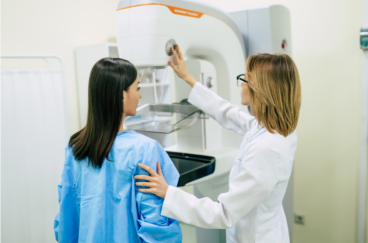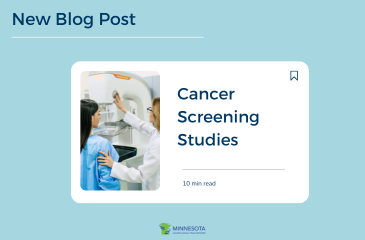All About Clinical Trials: Cancer Screening Studies
There are many different types of clinical trials and research studies, which can be intimidating for someone new to research. The wide clinical trial variety is a good thing, however, because it means there is likely a study opportunity for everyone! One type of research study is cancer screening studies, which you can learn all about below!
To learn other clinical trial basics and frequently asked questions, make sure you’re following MNCCTN on Facebook and Instagram where we share all kinds of education about clinical trials every week!
What Are Clinical Trials?
Clinical trials are research studies that look to answer questions about diseases such as cancer. People volunteer to participate in trials. Clinical trials are often associated with finding new treatments for diseases. In fact, all of today’s treatments for diseases were developed through clinical trials. Clinical trials can also study how to prevent diseases, reduce symptoms of diseases or side effects from treatments, and improve quality of life for survivors. Other trials study how to screen for diseases.
What Is Screening?
Screening is testing for a disease on people who aren’t showing any symptoms or signs of disease. Screening seeks to detect disease early so that it can be treated early. There are screening tests for multiple different cancers. Cancer screening can find cancer early, improve patient outcomes, increase survival time, and reduce chances of death. However, cancer screening doesn’t diagnose cancer. False positives in screening tests are possible. If something abnormal is found in screening, an individual must undergo further testing in order to make a diagnosis.
Cancer Screening Tests
There are common screening tests for four main cancers. All were developed through cancer research, and they are safe, effective, and recommended by experts. However, they have specific guidelines on who is eligible based on benefits and risks.

Breast Cancer
The main screening test for breast cancer is mammography. It is recommended that women begin regular mammograms at age 40. However, screening may start earlier for women with increased breast cancer risk due to family history, genetics, and other factors.
Cervical Cancer
The main screening tests for cervical cancer are the Pap smear (also referred to as Pap test) and HPV testing. These tests can occur individually or together at once. These screening tests can identify abnormal cells before they develop into cancer. It is recommended that women begin cervical cancer screening at age 21 and receive screening every three years. This recommendation may vary depending on an individual’s history and risk.
Colorectal Cancer
There are multiple screening methods for colorectal cancer, including colonoscopies, sigmoidoscopy, and stool tests. Colonoscopies are the most common screening method. These methods can detect polyps, which are abnormal growths that may or may not develop into cancer, or colorectal cancer early. By finding polyps, doctors can catch cancer early or prevent it altogether by removing polyps before cancer occurs. Experts recommend that people with average risk begin colorectal screening at age 45. Screening may be recommended earlier due to individual risk factors, such as family history, genetics, pre-existing conditions, and more.
Lung Cancer
Low-dose computed tomography is a screening method for lung cancer. This is a type of CT scan that takes multiple pictures of the lungs while the patient lays down. Then, it creates a detailed picture of the individual’s lungs. The picture will be analyzed by a radiologist to identify any abnormalities. This can diagnose lung cancer early before it worsens or spreads.
Low-dose CT screening is only recommended for past or current heavy smokers. Experts categorize this as individuals 50-80 who have a 20 pack-year smoking history and currently smoke or have quit within the past 15 years.
There are several other cancer screening tests that are less common and mainly used for people with higher risk. Learn more about these tests.
How Screening Studies Work
Screening studies can be interventional or observational depending on the study design.
For interventional screening trials, participants will be split into two or more groups. Each group will follow different study procedures. For most interventional screening trials, one group will undergo a new screening method. The other group will receive an existing screening method or no screening. Then, outcomes of each group will be compared to determine if the new screening is effective, safe, and/or better than current screening methods if they exist. In controlled trials, the participants are randomly assigned to a group. In uncontrolled trials, participants can pick which group they are in. Controlled trials lead to more conclusive results and stronger evidence than uncontrolled trials.
Observational screening studies usually follow groups of people over time to observe outcomes. One type of observational study is cohort studies. Cohort studies follow a group of people with a common characteristic over time and observe outcomes. This can occur by following people forward in time, or looking back to the past. For screening, this could involve following people who were screened and those who were not screened and comparing their health outcomes over time. For example, a study could have one group of women who were screened for cervical cancer and a second group of women who did not receive cervical cancer screening. The study would follow these groups over time and compare their cervical cancer outcomes, such as disease incidence and survival rates.
Future Screening Research
While there are existing screening methods for several cancers, there are no screening methods for the majority of cancers. Researchers are studying screening methods for other cancers. They are also developing methods that could test for multiple cancers at once through blood tests.
Another area of screening research is improving existing screening methods. This involves finding new methods, improving the effectiveness of current methods, and reducing the risks or complications of existing tests. Studies can also be used to determine if current screening guidelines based on ages and risk factors are suitable or if they need to be changed.
